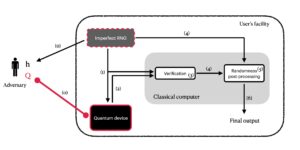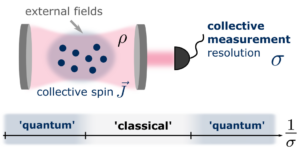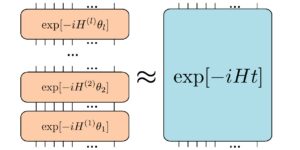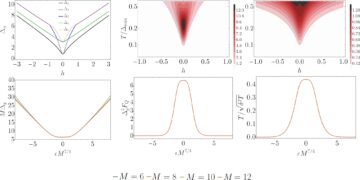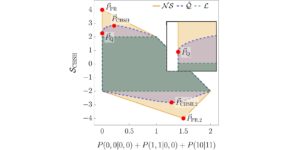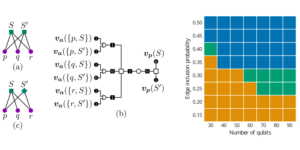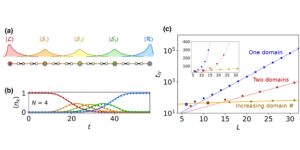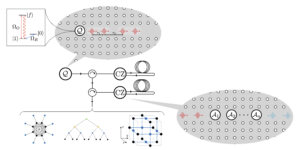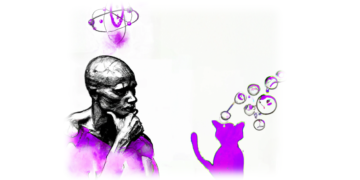1QuIC, École Polytechnique de Bruxelles, CP 165/59, Université Libre de Bruxelles, 1050 Brüssel, Belgien
2RCQI, Institut für Physik, Slowakische Akademie der Wissenschaften, Dúbravská cesta 9, Bratislava 84511, Slowakei
3Abteilung für Nukleartechnik, Universität Kyoto, Nishikyo-ku, Kyoto 615-8540, Japan
4Quantum Technology Group, Abteilung für Wissenschafts- und Industriesysteme, Universität Südostnorwegen, 3616 Kongsberg, Norwegen
Findest du dieses Paper interessant oder möchtest du darüber diskutieren? Scite oder hinterlasse einen Kommentar zu SciRate.
Abstrakt
Messfehler und Störungen werden bei Vorliegen von Erhaltungsgesetzen in allgemeiner betrieblicher Hinsicht analysiert. Wir liefern neuartige quantitative Grenzen, die die notwendigen Bedingungen aufzeigen, unter denen genaue oder störungsfreie Messungen erreicht werden können, und verdeutlichen ein interessantes Zusammenspiel zwischen Inkompatibilität, Unschärfe und Kohärenz. Von hier aus erhalten wir eine wesentliche Verallgemeinerung des Wigner-Araki-Yanase (WAY)-Theorems. Unsere Ergebnisse werden durch die Analyse des Festkommasatzes des Messkanals weiter verfeinert, dessen zusätzliche Struktur hier zum ersten Mal charakterisiert wird.
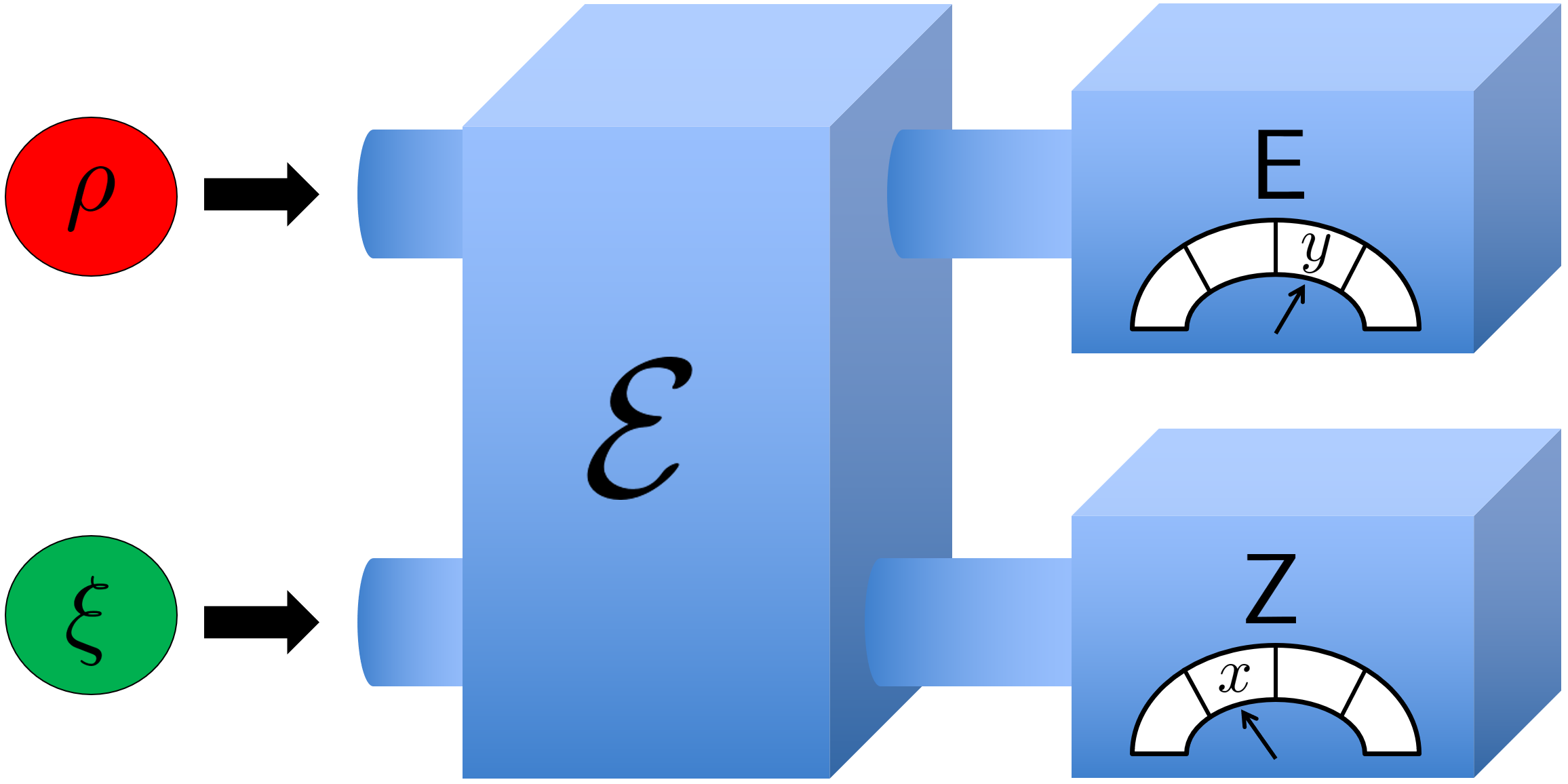
Ausgewähltes Bild: Das untersuchte System $mathcal{S}$ durchläuft eine sequentielle Messung eines beobachtbaren $mathsf{E}$. Die erste Messung wird als „Messvorgang“ bezeichnet, der durch eine Interaktion mit einem Messgerät $mathcal{A}$ realisiert wird. Dabei interagiert das zu messende System, zunächst in einem beliebigen Zustand $rho$ vorbereitet, mit der Messapparatur, zunächst in einem festen Zustand $xi$ vorbereitet, über einen Kanal $mathcal{E}$. Der Messvorgang ist abgeschlossen, wenn der beobachtbare Zeiger $mathsf{Z}$ des Geräts ein bestimmtes Ergebnis $x$ registriert. Der Messprozess implementiert eine genaue Messung von $mathsf{E}$, wenn die Wahrscheinlichkeit der Registrierung des Ergebnisses $x$ von $mathsf{Z}$ die Wahrscheinlichkeit der Born-Regel, das Ergebnis $x$ von $mathsf{E}$ zu registrieren, wiederherstellt Zustand $rho$. Andererseits stört der Messvorgang $mathsf{E}$ nicht, wenn die Statistiken von $mathsf{E}$ nach dem Messvorgang mit denen davor identisch sind. Wenn der Interaktionskanal $mathcal{E}$ eine additive Menge $N_mathcal{S} oft 1_mathcal{A} + 1_mathcal{S} oft N_mathcal{A}$ von System-plus-Apparat erhält, ist ein beobachtbares $mathsf{E}$ Nicht mit $N_mathcal{S}$ zu kommutieren, lässt nur dann eine genaue Messung zu (wenn die Zeiger-Observable mit $N_mathcal{A}$ pendelt) oder eine nicht störende Messung (für eine beliebige Zeiger-Observable), wenn dies bei $mathsf{E}$ nicht der Fall ist scharf, und nur wenn die Apparatepräparation $xi$ eine große Kohärenz in $N_mathcal{A}$ hat.
Populäre Zusammenfassung
Bei additiven Erhaltungsgrößen wie Energie, Ladung oder Drehimpuls gibt es Einschränkungen hinsichtlich der genauen und störungsfreien Messung einiger Observablen. Ein klassisches Ergebnis zu diesem Thema ist der Satz von Wigner-Araki-Yanase (WAY), der auf die $50$s/$60$s zurückgeht und besagt, dass, wenn die Messwechselwirkung einheitlich ist, die einzigen scharfen Observablen (entsprechend der Selbst- adjungierte Operatoren), die genaue oder nicht störende Messungen zulassen, sind diejenigen, die mit der Erhaltungsgröße pendeln.
In diesem Artikel verallgemeinern wir das WAY-Theorem, indem wir uns mit der Frage genauer oder störungsfreier Messungen (bei Vorliegen von Erhaltungsgesetzen) für Observable, die durch POVMs (positive Operator Value Measures) dargestellt werden, und Messinteraktionen, die durch Quantenkanäle dargestellt werden, befassen. Wir stellen fest, dass die Observablen nicht scharf sein können und das Messgerät in einem Zustand mit einer großen Kohärenz in der Erhaltungsgröße vorbereitet werden muss, um genaue oder störungsfreie Messungen für Observable zu erreichen, die nicht mit der Erhaltungsgröße kommutieren. Im Sinne des ursprünglichen WAY-Theorems finden wir daher sowohl ein No-Go-Ergebnis, das eine präzise Messung und Manipulation einzelner Quantenobjekte verbietet, als auch ein positives Gegenstück, das Bedingungen beschreibt, unter denen gute Messungen erzielt werden können.
► BibTeX-Daten
► Referenzen
[1] P. Busch, G. Cassinelli und PJ Lahti, Found. Physik. 20, 757 (1990).
https: / / doi.org/ 10.1007 / BF01889690
[2] M. Ozawa, Phys. Rev. A 67, 042105 (2003).
https: / / doi.org/ 10.1103 / PhysRevA.67.042105
[3] P. Busch, in Quantum Reality, Relativ. Kausalität, schließender epistemischer Zirkel. (Springer, Dordrecht, 2009), S. 229–256.
https://doi.org/10.1007/978-1-4020-9107-0_13
[4] T. Heinosaari und MM Wolf, J. Math. Physik. 51, 092201 (2010).
https: / / doi.org/ 10.1063 / 1.3480658
[5] M. Tsang und CM Caves, Phys. Rev. Lett. 105, 123601 (2010).
https://doi.org/ 10.1103/PhysRevLett.105.123601
[6] M. Tsang und CM Caves, Phys. Rev. X 2, 1 (2012).
https://doi.org/ 10.1103/PhysRevX.2.031016
[7] LA Rozema, A. Darabi, DH Mahler, A. Hayat, Y. Soudagar und AM Steinberg, Phys. Rev. Lett. 109, 100404 (2012).
https://doi.org/ 10.1103/PhysRevLett.109.100404
[8] JP Groen, D. Ristè, L. Tornberg, J. Cramer, PC de Groot, T. Picot, G. Johansson und L. DiCarlo, Phys. Rev. Lett. 111, 090506 (2013).
https://doi.org/ 10.1103/PhysRevLett.111.090506
[9] M. Hatridge, S. Shankar, M. Mirrahimi, F. Schackert, K. Geerlings, T. Brecht, KM Sliwa, B. Abdo, L. Frunzio, SM Girvin, RJ Schoelkopf und MH Devoret, Science (80-. ). 339, 178 (2013).
https: / / doi.org/ 10.1126 / science.1226897
[10] P. Busch, P. Lahti und RF Werner, Phys. Rev. Lett. 111, 160405 (2013).
https://doi.org/ 10.1103/PhysRevLett.111.160405
[11] P. Busch, P. Lahti und RF Werner, Rev. Mod. Physik. 86, 1261 (2014).
https: / / doi.org/ 10.1103 / RevModPhys.86.1261
[12] F. Kaneda, S.-Y. Baek, M. Ozawa und K. Edamatsu, Phys. Rev. Lett. 112, 020402 (2014).
https://doi.org/ 10.1103/PhysRevLett.112.020402
[13] MS Blok, C. Bonato, ML Markham, DJ Twitchen, VV Dobrovitski und R. Hanson, Nat. Physik. 10, 189 (2014).
https: / / doi.org/ 10.1038 / nphys2881
[14] T. Shitara, Y. Kuramochi und M. Ueda, Phys. Rev. A 93, 032134 (2016).
https: / / doi.org/ 10.1103 / PhysRevA.93.032134
[15] CB Møller, RA Thomas, G. Vasilakis, E. Zeuthen, Y. Tsaturyan, M. Balabas, K. Jensen, A. Schliesser, K. Hammerer und ES Polzik, Nature 547, 191 (2017).
https: / / doi.org/ 10.1038 / nature22980
[16] I. Hamamura und T. Miyadera, J. Math. Physik. 60, 082103 (2019).
https: / / doi.org/ 10.1063 / 1.5109446
[17] C. Carmeli, T. Heinosaari, T. Miyadera und A. Toigo, Gefunden. Physik. 49, 492 (2019).
https://doi.org/10.1007/s10701-019-00255-1
[18] K.-D. Wu, E. Bäumer, J.-F. Tang, KV Hovhannisyan, M. Perarnau-Llobet, G.-Y. Xiang, C.-F. Li und G.-C. Guo, Phys. Rev. Lett. 125, 210401 (2020).
https://doi.org/ 10.1103/physrevlett.125.210401
[19] GM D'Ariano, P. Perinotti und A. Tosini, Quantum 4, 363 (2020).
https://doi.org/10.22331/q-2020-11-16-363
[20] AC Ipsen, gefunden. Physik. 52, 20 (2022).
https: / / doi.org/ 10.1007 / s10701-021-00534-w
[21] T. Heinosaari, T. Miyadera und M. Ziman, J. Phys. Eine Mathematik. Theor. 49, 123001 (2016).
https://doi.org/10.1088/1751-8113/49/12/123001
[22] O. Gühne, E. Haapasalo, T. Kraft, J.-P. Pellonpää und R. Uola, Rev. Mod. Physik. 95, 011003 (2023).
https: / / doi.org/ 10.1103 / RevModPhys.95.011003
[23] EP Wigner, Zeitschrift für Phys. Ein Hadron. Nukl. 133, 101 (1952).
https: / / doi.org/ 10.1007 / BF01948686
[24] P. Busch, (2010), arXiv:1012.4372.
arXiv: 1012.4372
[25] H. Araki und MM Yanase, Phys. Rev. 120, 622 (1960).
https: / / doi.org/ 10.1103 / PhysRev.120.622
[26] L. Loveridge und P. Busch, Eur. Physik. J. D 62, 297 (2011).
https: / / doi.org/ 10.1140 / epjd / e2011-10714-3
[27] T. Miyadera und H. Imai, Phys. Rev. A 74, 024101 (2006).
https: / / doi.org/ 10.1103 / PhysRevA.74.024101
[28] G. Kimura, B. Meister und M. Ozawa, Phys. Rev. A 78, 032106 (2008).
https: / / doi.org/ 10.1103 / PhysRevA.78.032106
[29] P. Busch und L. Loveridge, Phys. Rev. Lett. 106, 110406 (2011).
https://doi.org/ 10.1103/PhysRevLett.106.110406
[30] P. Busch und LD Loveridge, in Symmetries Groups Contemp. Physik. (WORLD SCIENTIFIC, 2013) S. 587–592.
https: / / doi.org/ 10.1142 / 9789814518550_0083
[31] A. Łuczak, Open Syst. Inf. Dyn. 23, 1 (2016).
https: / / doi.org/ 10.1142 / S123016121650013X
[32] M. Tukiainen, Phys. Rev. A 95, 012127 (2017).
https: / / doi.org/ 10.1103 / PhysRevA.95.012127
[33] H. Tajima und H. Nagaoka, (2019), arXiv:1909.02904.
arXiv: 1909.02904
[34] S. Sołtan, M. Frączak, W. Belzig und A. Bednorz, Phys. Rev. Res. 3, 013247 (2021).
https: / / doi.org/ 10.1103 / PhysRevResearch.3.013247
[35] M. Ozawa, Phys. Rev. Lett. 89, 3 (2002a).
https://doi.org/ 10.1103/PhysRevLett.89.057902
[36] T. Karasawa und M. Ozawa, Phys. Rev. A 75, 032324 (2007).
https: / / doi.org/ 10.1103 / PhysRevA.75.032324
[37] T. Karasawa, J. Gea-Banacloche und M. Ozawa, J. Phys. Eine Mathematik. Theor. 42, 225303 (2009).
https://doi.org/10.1088/1751-8113/42/22/225303
[38] M. Ahmadi, D. Jennings und T. Rudolph, New J. Phys. 15, 013057 (2013).
https://doi.org/10.1088/1367-2630/15/1/013057
[39] J. Åberg, Phys. Rev. Lett. 113, 150402 (2014).
https://doi.org/ 10.1103/PhysRevLett.113.150402
[40] H. Tajima, N. Shiraishi und K. Saito, Phys. Rev. Res. 2, 043374 (2020).
https: / / doi.org/ 10.1103 / PhysRevResearch.2.043374
[41] L. Loveridge, T. Miyadera und P. Busch, Gefunden. Physik. 48, 135 (2018).
https://doi.org/10.1007/s10701-018-0138-3
[42] L. Loveridge, J. Phys. Konf. Ser. 1638, 012009 (2020).
https://doi.org/10.1088/1742-6596/1638/1/012009
[43] N. Gisin und E. Zambrini Cruzeiro, Ann. Physik. 530, 1700388 (2018).
https: / / doi.org/ 10.1002 / andp.201700388
[44] M. Navascués und S. Popescu, Phys. Rev. Lett. 112, 140502 (2014).
https://doi.org/ 10.1103/PhysRevLett.112.140502
[45] MH Mohammady und J. Anders, New J. Phys. 19, 113026 (2017).
https://doi.org/10.1088/1367-2630/aa8ba1
[46] MH Mohammady und A. Romito, Quantum 3, 175 (2019).
https://doi.org/10.22331/q-2019-08-19-175
[47] G. Chiribella, Y. Yang und R. Renner, Phys. Rev. X 11, 021014 (2021).
https://doi.org/ 10.1103/PhysRevX.11.021014
[48] MH Mohammady, Phys. Rev. A 104, 062202 (2021a).
https: / / doi.org/ 10.1103 / PhysRevA.104.062202
[49] P. Busch, P. Lahti, J.-P. Pellonpää und K. Ylinen, Quantum Measurement, Theoretical and Mathematical Physics (Springer International Publishing, Cham, 2016).
https://doi.org/10.1007/978-3-319-43389-9
[50] P. Busch, M. Grabowski und PJ Lahti, Operational Quantum Physics, Lecture Notes in Physics Monographs, Bd. 31 (Springer Berlin Heidelberg, Berlin, Heidelberg, 1995).
https://doi.org/10.1007/978-3-540-49239-9
[51] P. Busch, PJ Lahti und Peter Mittelstaedt, The Quantum Theory of Measurement, Lecture Notes in Physics Monographs, Bd. 2 (Springer Berlin Heidelberg, Berlin, Heidelberg, 1996).
https://doi.org/10.1007/978-3-540-37205-9
[52] T. Heinosaari und M. Ziman, The Mathematical language of Quantum Theory (Cambridge University Press, Cambridge, 2011).
https: / / doi.org/ 10.1017 / CBO9781139031103
[53] B. Janssens, Lett. Mathematik. Physik. 107, 1557 (2017).
https: / / doi.org/ 10.1007 / s11005-017-0953-z
[54] O. Bratteli und DW Robinson, Operator Algebras and Quantum Statistical Mechanics 1 (Springer Berlin Heidelberg, Berlin, Heidelberg, 1987).
https://doi.org/10.1007/978-3-662-02520-8
[55] O. Bratteli, PET Jorgensen, A. Kishimoto und RF Werner, J. Oper. Theorie 43, 97 (2000).
https: // www.jstor.org/stable/24715231
[56] EB Davies und JT Lewis, Commun. Mathematik. Physik. 17, 239 (1970).
https: / / doi.org/ 10.1007 / BF01647093
[57] M. Ozawa, Phys. Rev. A 62, 062101 (2000).
https: / / doi.org/ 10.1103 / PhysRevA.62.062101
[58] M. Ozawa, Phys. Rev. A 63, 032109 (2001).
https: / / doi.org/ 10.1103 / PhysRevA.63.032109
[59] J.-P. Pellonpää, J. Phys. Eine Mathematik. Theor. 46, 025302 (2013a).
https://doi.org/10.1088/1751-8113/46/2/025302
[60] J.-P. Pellonpää, J. Phys. Eine Mathematik. Theor. 46, 025303 (2013b).
https://doi.org/10.1088/1751-8113/46/2/025303
[61] G. Lüders, Ann. Physik. 518, 663 (2006).
https: / / doi.org/ 10.1002 / andp.20065180904
[62] M.Ozawa, J.Math. Phys. 25, 79 (1984).
https: / / doi.org/ 10.1063 / 1.526000
[63] P. Busch und J. Singh, Phys. Lette. A 249, 10 (1998).
https://doi.org/10.1016/S0375-9601(98)00704-X
[64] P. Busch, M. Grabowski und PJ Lahti, Found. Physik. 25, 1239 (1995b).
https: / / doi.org/ 10.1007 / BF02055331
[65] PJ Lahti, P. Busch und P. Mittelstaedt, J. Math. Physik. 32, 2770 (1991).
https: / / doi.org/ 10.1063 / 1.529504
[66] MM Yanase, Phys. Rev. 123, 666 (1961).
https: / / doi.org/ 10.1103 / PhysRev.123.666
[67] M. Ozawa, Phys. Rev. Lett. 88, 050402 (2002b).
https://doi.org/ 10.1103/PhysRevLett.88.050402
[68] I. Marvian und RW Spekkens, Nat. Kommun. 5, 3821 (2014).
https: / / doi.org/ 10.1038 / ncomms4821
[69] C. Cı̂rstoiu, K. Korzekwa und D. Jennings, Phys. Rev. X 10, 041035 (2020).
https://doi.org/ 10.1103/PhysRevX.10.041035
[70] D. Petz und C. Ghinea, Quantum Probab. Verwandt. Spitze. (World Scientific, Singapur, 2011), S. 261–281.
https: / / doi.org/ 10.1142 / 9789814338745_0015
[71] A. Streltsov, G. Adesso und MB Plenio, Rev. Mod. Phys. 89, 041003 (2017).
https: / / doi.org/ 10.1103 / RevModPhys.89.041003
[72] R. Takagi, Sci. Rep. 9, 14562 (2019).
https: / / doi.org/ 10.1038 / s41598-019-50279-w
[73] I. Marvian, Phys. Rev. Lett. 129, 190502 (2022).
https://doi.org/ 10.1103/PhysRevLett.129.190502
[74] G. Tóth und D. Petz, Phys. Rev. A 87, 032324 (2013).
https: / / doi.org/ 10.1103 / PhysRevA.87.032324
[75] S. Yu, (2013), arXiv:1302.5311.
arXiv: 1302.5311
[76] L. Weihua und W. Junde, J. Phys. Eine Mathematik. Theor. 43, 395206 (2010).
https://doi.org/10.1088/1751-8113/43/39/395206
[77] B. Prunaru, J. Phys. Eine Mathematik. Theor. 44, 185203 (2011).
https://doi.org/10.1088/1751-8113/44/18/185203
[78] A. Arias, A. Gheondea und S. Gudder, J. Math. Physik. 43, 5872 (2002).
https: / / doi.org/ 10.1063 / 1.1519669
[79] L. Weihua und W. Junde, J. Math. Physik. 50, 103531 (2009).
https: / / doi.org/ 10.1063 / 1.3253574
[80] GM D'Ariano, P. Perinotti und M. Sedlák, J. Math. Physik. 52, 082202 (2011).
https: / / doi.org/ 10.1063 / 1.3610676
[81] MH Mohammady, Phys. Rev. A 103, 042214 (2021b).
https: / / doi.org/ 10.1103 / PhysRevA.103.042214
[82] V. Pata, Fixed Point Theorems and Applications, UNITEXT, Bd. 116 (Springer International Publishing, Cham, 2019).
https://doi.org/10.1007/978-3-030-19670-7
[83] G. Pisier, Einführung in die Operatorraumtheorie (Cambridge University Press, 2003).
https: / / doi.org/ 10.1017 / CBO9781107360235
[84] Y. Kuramochi und H. Tajima, (2022), arXiv:2208.13494.
arXiv: 2208.13494
[85] RV Kadison, Ann. Mathematik. 56, 494 (1952).
https: / / doi.org/ 10.2307 / 1969657
[86] M.-D. Choi, Illinois J. Math. 18, 565 (1974).
https: / / doi.org/ 10.1215 / ijm / 1256051007
[87] WF Stinespring, Proc. Am. Mathematik. Soc. 6, 211 (1955).
https: / / doi.org/ 10.2307 / 2032342
[88] T. Miyadera und H. Imai, Phys. Rev. A 78, 052119 (2008).
https: / / doi.org/ 10.1103 / PhysRevA.78.052119
[89] T. Miyadera, L. Loveridge und P. Busch, J. Phys. Eine Mathematik. Theor. 49, 185301 (2016).
https://doi.org/10.1088/1751-8113/49/18/185301
[90] K. Kraus, States, Effects, and Operations Fundamental Notions of Quantum Theory, herausgegeben von K. Kraus, A. Böhm, JD Dollard und WH Wootters, Lecture Notes in Physics, Bd. 190 (Springer Berlin Heidelberg, Berlin, Heidelberg, 1983).
https://doi.org/10.1007/3-540-12732-1
[91] P. Lahti, Int. J. Theor. Physik. 42, 893 (2003).
https: / / doi.org/ 10.1023 / A: 1025406103210
[92] J.-P. Pellonpää, J. Phys. Eine Mathematik. Theor. 47, 052002 (2014).
https://doi.org/10.1088/1751-8113/47/5/052002
[93] S. Luo und Q. Zhang, Theor. Mathematik. Physik. 151, 529 (2007).
https://doi.org/10.1007/s11232-007-0039-7
[94] GM D'Ariano, PL Presti und P. Perinotti, J. Phys. A. Mathe. Gen. 38, 5979 (2005).
https://doi.org/10.1088/0305-4470/38/26/010
[95] CA Fuchs und CM Caves, Open Syst. Inf. Dyn. 3, 345 (1995).
https: / / doi.org/ 10.1007 / BF02228997
[96] H. Barnum, CM Caves, CA Fuchs, R. Jozsa und B. Schumacher, Phys. Rev. Lett. 76, 2818 (1996).
https://doi.org/ 10.1103/PhysRevLett.76.2818
Zitiert von
[1] Yui Kuramochi und Hiroyasu Tajima, „Wigner-Araki-Yanase-Theorem für kontinuierliche und unbegrenzte konservierte Observablen“, arXiv: 2208.13494, (2022).
[2] M. Hamed Mohammady und Takayuki Miyadera, „Quantenmessungen eingeschränkt durch den dritten Hauptsatz der Thermodynamik“, arXiv: 2209.06024, (2022).
[3] M. Hamed Mohammady, „Thermodynamisch freie Quantenmessungen“, arXiv: 2205.10847, (2022).
[4] Lauritz van Luijk, Reinhard F. Werner und Henrik Wilming: „Kovariante Katalyse erfordert Korrelationen und gute Quantenreferenzrahmen verschlechtern sich kaum“, arXiv: 2301.09877, (2023).
[5] M. Hamed Mohammady, „Thermodynamisch freie Quantenmessungen“, Journal of Physics A Mathematical General 55 50, 505304 (2022).
[6] M. Hamed Mohammady und Takayuki Miyadera, „Quantenmessungen eingeschränkt durch den dritten Hauptsatz der Thermodynamik“, Physische Überprüfung A 107 2, 022406 (2023).
Die obigen Zitate stammen von SAO / NASA ADS (Zuletzt erfolgreich aktualisiert am 2023, 06:05:13 Uhr). Die Liste ist möglicherweise unvollständig, da nicht alle Verlage geeignete und vollständige Zitationsdaten bereitstellen.
Konnte nicht abrufen Crossref zitiert von Daten während des letzten Versuchs 2023-06-05 13:40:10: Von Crossref konnten keine zitierten Daten für 10.22331 / q-2023-06-05-1033 abgerufen werden. Dies ist normal, wenn der DOI kürzlich registriert wurde.
Dieses Papier ist in Quantum unter dem veröffentlicht Creative Commons Namensnennung 4.0 International (CC BY 4.0) Lizenz. Das Copyright verbleibt bei den ursprünglichen Copyright-Inhabern wie den Autoren oder deren Institutionen.
- SEO-gestützte Content- und PR-Distribution. Holen Sie sich noch heute Verstärkung.
- PlatoAiStream. Web3-Datenintelligenz. Wissen verstärkt. Hier zugreifen.
- Die Zukunft prägen mit Adryenn Ashley. Hier zugreifen.
- Kaufen und verkaufen Sie Anteile an PRE-IPO-Unternehmen mit PREIPO®. Hier zugreifen.
- Quelle: https://quantum-journal.org/papers/q-2023-06-05-1033/
- :hast
- :Ist
- :nicht
- ][P
- 1
- 10
- 107
- 11
- 116
- 12
- 1239
- 13
- 14
- 15%
- 16
- 17
- 1996
- 1998
- 20
- 2001
- 2005
- 2006
- 2008
- 2011
- 2012
- 2013
- 2014
- 2016
- 2017
- 2018
- 2019
- 2020
- 2021
- 2022
- 2023
- 22
- 23
- 24
- 26
- 27
- 28
- 30
- 31
- 39
- 40
- 49
- 50
- 60
- 66
- 67
- 7
- 70
- 72
- 77
- 8
- 80
- 84
- 87
- 9
- 91
- 98
- a
- oben
- ABSTRACT
- Academy
- Zugang
- genau
- Erreichen
- erreicht
- Adressierung
- eingestehen
- Zugehörigkeiten
- Nach der
- Alle
- erlaubt
- am
- an
- Analyse
- und
- Angular
- jedem
- Anwendungen
- SIND
- AS
- Autor
- Autoren
- Zurück
- BE
- Berlin
- zwischen
- BLOCK
- geboren
- beide
- Break
- Brüssel
- Busch
- by
- Cambridge
- CAN
- kann keine
- Kanal
- Kanäle
- dadurch gekennzeichnet
- berechnen
- klassisch
- Schließen
- Kommentar
- Unterhaus
- Pendeln
- Pendeln
- abschließen
- Abgeschlossene Verkäufe
- Bedingungen
- CONSERVATION
- kontinuierlich
- Urheberrecht
- Dazugehörigen
- könnte
- Gegenstück
- technische Daten
- Datum
- demonstrieren
- Es
- Abteilung
- diskutieren
- do
- die
- im
- e
- Effekten
- Energie
- Entwicklung
- Fehler
- Äther (ETH)
- EUR
- extra
- Finden Sie
- Befund
- Vorname
- erstes Mal
- fixiert
- Aussichten für
- formal
- gefunden
- Unser Ansatz
- Frei
- für
- fundamental
- weiter
- Jan
- Allgemeines
- gegeben
- gut
- Gruppe an
- Gruppen
- Pflege
- Harvard
- hier
- Hervorheben
- Inhaber
- HTTPS
- i
- identisch
- if
- Illinois
- Image
- implementiert
- in
- Krankengymnastik
- Energiegewinnung
- anfänglich
- Institut
- Institutionen
- Interaktion
- Interaktionen
- interagiert
- interessant
- International
- Einleitung
- Untersuchung
- IT
- JavaScript
- Zeitschrift
- Sprache
- grosse
- Nachname
- Recht
- Gesetze
- Verlassen
- Lesen
- Lewis
- li
- Lizenz
- Liste
- wenig
- Manipulation
- Mathe
- mathematisch
- max-width
- Kann..
- Messung
- Messungen
- Maßnahmen
- Messen
- Mechanik
- Schwung
- Monat
- sollen
- Natur
- notwendig,
- Neu
- normal
- Norwegen
- Notizen
- Roman
- Kernenergie
- Objekte
- erhalten
- of
- on
- einzige
- XNUMXh geöffnet
- Betriebs-
- Einkauf & Prozesse
- Operator
- Betreiber
- or
- Auftrag
- Original
- Andere
- UNSERE
- Ergebnis
- Papier
- Jürgen
- physikalisch
- Physik
- Plato
- Datenintelligenz von Plato
- PlatoData
- Points
- positiv
- präzise
- Vorbereitung
- bereit
- Präsenz
- Presse
- Vor
- Wahrscheinlichkeit
- PROC
- Prozessdefinierung
- die
- veröffentlicht
- Herausgeber
- Verlag
- Publishing
- quantitativ
- Menge
- Quant
- Quantenmessung
- Quantenmechanik
- Quantenobjekte
- Quantenphysik
- Frage
- Realität
- realisiert
- kürzlich
- Erholt sich
- Referenzen
- raffiniert
- eingetragen
- Registrieren
- registriert
- bleibt bestehen
- vertreten
- erfordert
- Einschränkungen
- Folge
- was zu
- Überprüfen
- Regel
- ausgeschlossen
- s
- SCI
- Wissenschaft
- WISSENSCHAFTEN
- kompensieren
- scharf
- Singapur
- einige
- Raumfahrt
- Geist
- Bundesstaat
- Staaten
- statistisch
- Statistiken
- Struktur
- Studie
- wesentlich
- Erfolgreich
- so
- geeignet
- System
- Systeme und Techniken
- Technologie
- AGB
- zur Verbesserung der Gesundheitsgerechtigkeit
- Das
- Der Staat
- ihr
- dann
- theoretisch
- Theorie
- Dort.
- deswegen
- Dritte
- fehlen uns die Worte.
- diejenigen
- Durch
- Zeit
- Titel
- zu
- Top
- Thema
- für
- Universität
- aktualisiert
- URL
- geschätzt
- Volumen
- W
- wollen
- wurde
- Weg..
- we
- wann
- welche
- während
- mit
- Wolf
- weltweit wie ausgehandelt und gekauft ausgeführt wird.
- wu
- X
- Jahr
- Zephyrnet

